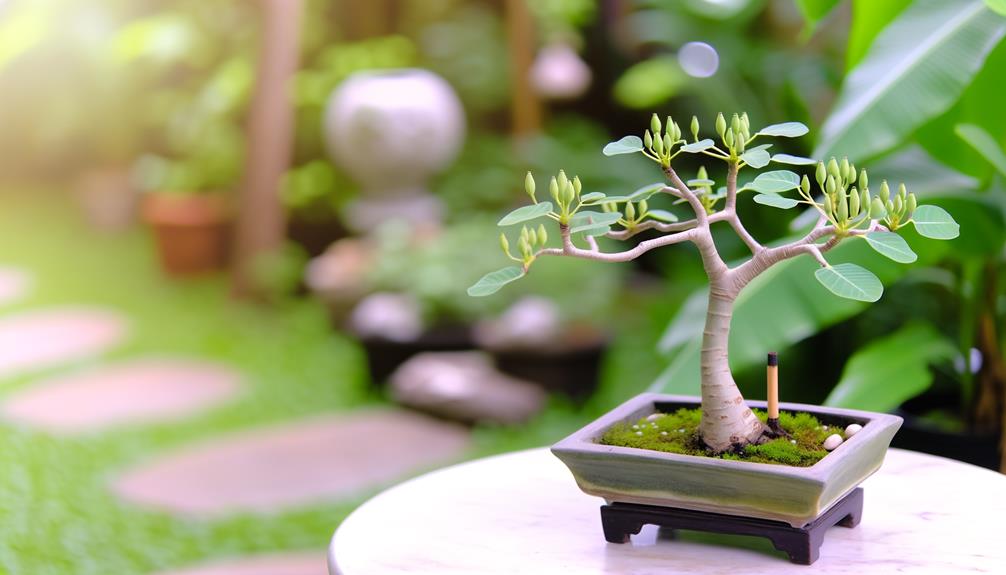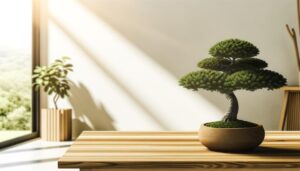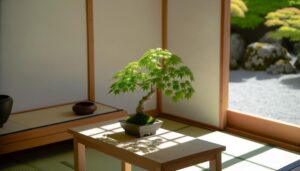How You Can Bonsai a Banana Tree – Step-by-Step Guide
Bonsaiing a banana tree is achievable with specific horticultural techniques and a deep understanding of the plant's biology. Banana trees, large herbaceous plants with pseudostems, require tropical climates, high humidity, and well-draining soil.
Choose dwarf varieties like 'Truly Tiny' for ease of bonsai cultivation. Using methods such as pruning, wiring, and root reduction, you can control their rapid growth and maintain miniature proportions.
Consistent watering, high potassium fertilizers, and disease management are crucial for a healthy bonsai. Mastering these critical elements can transform a banana tree into an alluring bonsai specimen.
Further exploration into bonsai methods will reveal essential practices for success.

Key Takeaways
- Yes, you can bonsai a banana tree using dwarf varieties like 'Truly Tiny' and 'Dwarf Cavendish'.
- Pruning, wiring, and root reduction are essential techniques for creating a bonsai banana tree.
- High humidity, adequate sunlight, and well-draining soil are crucial for banana bonsai cultivation.
- Regular watering, fertilizing, and pest control are vital for maintaining the health of a bonsai banana tree.
- Smaller leaves and compact root systems are ideal for achieving the miniature appearance of a bonsai banana tree.
Understanding Banana Trees

Banana trees (Musa spp.) are large, herbaceous plants that belong to the Musaceae family and are characterized by their thick pseudostems and large, broad leaves. These pseudostems are formed from tightly packed leaf bases, giving the plant its tree-like appearance.
The true stem is a rhizome located underground, from which suckers, or offshoots, emerge. Banana trees thrive in tropical and subtropical climates, requiring well-draining soil, high humidity, and consistent moisture for best growth.
They exhibit rapid growth, reaching heights of 10-30 feet within a single growing season. Understanding the unique physiology of banana trees is essential when considering their potential for bonsai cultivation, as their rapid growth and large leaf size present specific challenges and considerations for bonsai enthusiasts.
Basics of Bonsai Art
The practice of bonsai, originating from ancient Chinese horticultural traditions and refined by Japanese artisans, involves meticulous techniques such as pruning, wiring, and root reduction to create miniature trees.
Key tools for bonsai cultivation include concave cutters, branch benders, and specialized shears, each designed to execute precise modifications while minimizing plant stress.
Mastery of these tools and techniques is essential for successfully transforming a banana tree into a resilient and aesthetically pleasing bonsai specimen.
Historical Bonsai Techniques
While the art of bonsai cultivation originated in China over a thousand years ago, it was the Japanese who refined and popularized the intricate techniques that form the foundation of modern bonsai practices. Key historical techniques include:
- Pruning: This involves the selective removal of parts of the plant to control its shape and size, encouraging desired growth patterns.
- Wiring: Applying wire to branches allows precise manipulation of their direction and curvature, enabling the creation of aesthetically pleasing forms.
- Root Reduction: By trimming roots, the tree's growth is restricted, maintaining the desired miniature size while promoting a robust root system.
- Repotting: Regular repotting refreshes the soil, facilitates root pruning, and ensures best nutrient availability, critical for long-term health.
These foundational techniques remain integral to bonsai cultivation today.
Essential Bonsai Tools
A well-curated set of bonsai tools is essential for executing the detailed techniques required in bonsai cultivation. Including concave cutters, bonsai shears, and wire pliers. Concave cutters are specifically designed to create clean and precise cuts, promoting quicker healing and minimizing scars on the tree.
Bonsai shears provide the dexterity needed to trim delicate branches and leaves accurately. Wire pliers are indispensable for bending and shaping branches, allowing for the meticulous crafting of the tree's form.
Additionally, root rakes and knob cutters help manage root structures and remove unwanted growths, respectively. Each tool serves a specialized function, ensuring that the bonsai artist can maintain the health and aesthetics of their miniature trees with precision and care.
Selecting the Right Banana Species

Choosing the right banana species is essential for successful bonsai cultivation, with dwarf varieties like Musa 'Truly Tiny' being especially fitting due to their manageable size and growth traits.
Grasping the climate and environmental needs of these species, including temperature, humidity, and light conditions, guarantees best growth.
Moreover, offering specific care, such as regulated watering and occasional pruning, sustains the health and visual appeal of the bonsai banana tree.
Dwarf Banana Varieties
Identifying suitable dwarf banana varieties is crucial for successful bonsai cultivation, as these species possess the necessary compact growth habits that make them ideal for container gardening. Renowned for their manageable size and ornamental appeal, the following dwarf varieties are particularly recommended:
- Musa acuminata 'Dwarf Cavendish': Known for its short stature and broad leaves, this variety reaches a maximum height of 4-6 feet.
- Musa acuminata 'Super Dwarf Cavendish': An even more compact version, it typically grows to 2-4 feet, making it ideal for limited spaces.
- Musa velutina: This species produces small, ornamental pink bananas and grows to approximately 3-5 feet.
- Musa 'Truly Tiny': As its name suggests, this variety is extremely small, often staying under 3 feet, perfect for bonsai enthusiasts.
Selecting these specific varieties guarantees compatibility with bonsai techniques.
Climate and Environment Needs
Understanding the climatic and environmental requirements of banana species is necessary for successfully cultivating them as bonsai specimens. Banana trees thrive in tropical and subtropical climates, requiring temperatures between 75-95°F (24-35°C) and high humidity levels.
Species selection is paramount; dwarf varieties like Musa 'Truly Tiny' or Musa acuminata are preferable due to their manageable size and adaptability. Adequate sunlight is essential; these plants need 10-12 hours of indirect, bright light daily.
Soil composition must be well-draining yet moisture-retentive, typically achieved with a mix of loam, sand, and organic matter. Additionally, maintaining consistent moisture levels without waterlogging is crucial, as is ensuring good air circulation to prevent fungal diseases.
Selecting the right species and simulating best conditions are foundational to successful banana bonsai cultivation.
Growth and Maintenance Tips
When cultivating a banana tree as a bonsai, selecting a species with inherent dwarf characteristics, such as Musa 'Truly Tiny' or Musa acuminata, is crucial for accommodating the size constraints and growth habits necessary for bonsai aesthetics. Choosing the appropriate species guarantees manageable growth and proportional foliage.
Here are key considerations:
- Growth Rate: Opt for slower-growing species to facilitate easier maintenance and control.
- Root System: Choose species with compact root systems to fit within the confined bonsai pot.
- Leaf Size: Select species with smaller leaves to maintain the miniature appearance.
- Climate Adaptability: Make sure the species can thrive in your local climate to prevent stress.
Adhering to these guidelines will help maintain the health and visual appeal of your bonsai banana tree.
Potting and Soil Requirements
Choosing the right pot and soil mix is fundamental for the successful growth of a bonsai banana tree, as these elements directly impact root health and overall plant vitality.
A well-draining container with ample depth is crucial to accommodate the banana tree's extensive root system. Make sure the pot has drainage holes to prevent water accumulation, which can result in root decay.
The perfect soil mix should consist of a combination of organic materials, such as peat moss or compost, and non-organic components like perlite or sand. This blend guarantees proper aeration and moisture retention.
Regularly check soil acidity, aiming for a slightly acidic to neutral range (pH 5.5-7), to support optimal nutrient uptake.
Pruning Techniques

Effective pruning techniques are essential for maintaining the structural integrity and aesthetic appeal of a bonsai banana tree. Proper pruning promotes healthy growth, prevents disease, and enhances the miniature tree's overall appearance.
Here are key steps to take into account:
- Identify Primary Branches: Concentrate on the main branches that will shape the tree's form. Eliminate any weak or crossing branches to encourage a strong structure.
- Seasonal Pruning: Carry out major pruning during the tree's dormant season to reduce stress and stimulate vigorous regrowth.
- Leaf Trimming: Regularly trim large leaves to preserve the proportion of the bonsai, making sure they do not overshadow the tree's miniature aesthetic.
- Tool Sterilization: Always use sterilized pruning tools to prevent the spread of pathogens, thereby safeguarding the tree's health.
These methods secure a healthy and visually appealing bonsai banana tree.
Watering and Fertilizing
Proper watering and fertilizing practices are necessary for sustaining the health and vigor of a bonsai banana tree, ensuring balanced growth and ideal nutrient uptake.
Consistent and moderate watering is important; the soil should remain moist but not waterlogged to prevent root rot. Utilizing well-draining soil can aid in maintaining best moisture levels.
Fertilization should be approached with a balanced, slow-release fertilizer high in potassium, essential for robust growth and fruit development. Applying fertilizer every two weeks during the growing season helps maintain nutrient equilibrium.
Additionally, micronutrients like magnesium and iron should be supplemented periodically to prevent deficiencies. Monitoring the tree's response to watering and fertilizing practices is crucial for making necessary adjustments.
Common Challenges and Solutions

Despite careful watering and fertilizing, bonsai banana trees can still face challenges such as pest infestations, fungal diseases, and insufficient light, all of which demand targeted solutions to secure plant health and longevity.
- Pest Infestations: Regularly check leaves for aphids and spider mites. Use neem oil or insecticidal soap as a corrective measure.
- Fungal Diseases: Ensure proper air circulation and avoid excessive watering. Apply fungicides if symptoms like leaf spots or root rot appear.
- Insufficient Light: Bonsai banana trees require bright, indirect light. Supplement natural light with grow lights if necessary.
- Nutrient Deficiencies: Conduct soil tests to identify deficient nutrients. Improve soil with balanced fertilizers high in potassium and phosphorus.
Promptly addressing these issues can maintain the vitality and beauty of your bonsai banana tree.
Conclusion
The cultivation of a banana tree as a bonsai is achievable by adhering to the principles of bonsai art, selecting appropriate species, and maintaining strict care protocols.
Despite the challenge of managing a tropical plant in a miniature form, success can be achieved through meticulous pruning, ideal soil selection, and precise watering and fertilization.
Addressing concerns regarding the feasibility, detailed techniques and practical guidance guarantee that bonsai enthusiasts can effectively manage this unique horticultural endeavor.






